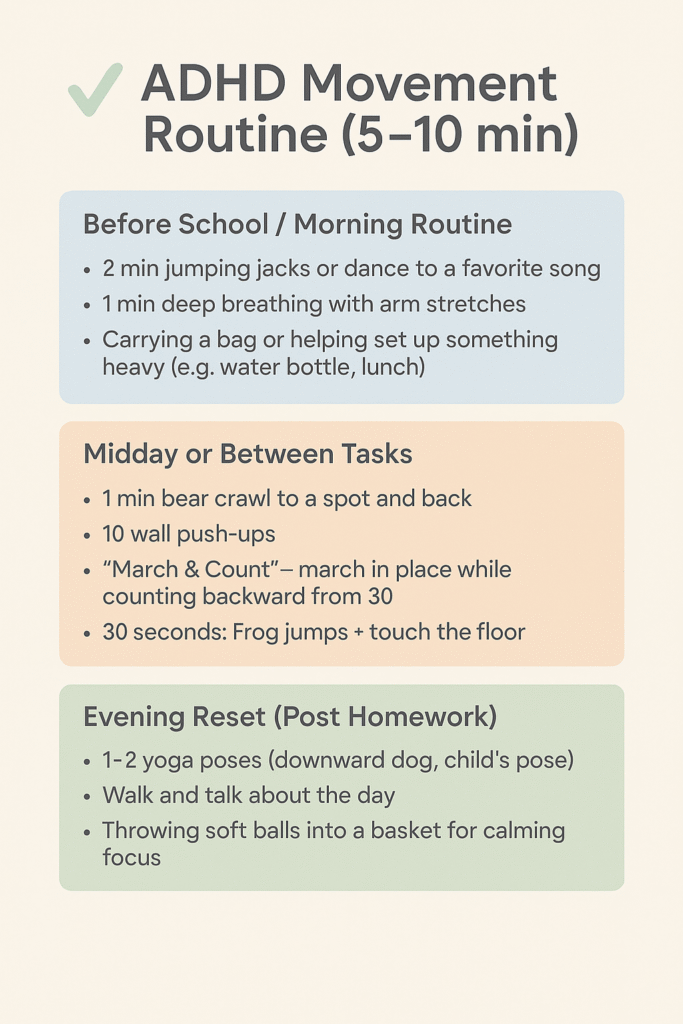Think of how hard it is to concentrate when you’re hungry, anxious or full of restless energy. For many children with ADHD, that’s their everyday experience except the restlessness doesn’t go away until they move. Their brains crave stimulation and without it, their minds may struggle to settle and focus.
It’s a common myth that children with ADHD can’t pay attention. In reality, they often have too much attention, just not always directed at the task in front of them. And while it may seem like movement is a distraction, for many kids, it’s actually the opposite. Movement isn’t a disruption, it’s a regulation strategy.
ADHD (Attention-Deficit/Hyperactivity Disorder) is a neurodevelopmental condition that affects how the brain manages attention, energy levels, and impulse control. ADHD presents in three primary types: inattentive, hyperactive-impulsive or combined.

In practical terms, this often means:
Difficulty staying focused on one thing Trouble sitting still for long periods Acting without thinking (impulsivity)
These aren’t merely a behavioral choice. They’re linked to how the ADHD brain is wired, especially in areas like the prefrontal cortex (responsible for planning, focus, and self-regulation) and low availability of neurotransmitters like dopamine. (Arnsten, 2009). This part of the brain often matures later in children with ADHD which can make it harder to manage impulses, stay organised, or focus on one task.
How Fidgeting Helps ADHD brains focus
One of the most common and visible behaviours in ADHD is fidgeting. It’s a neurobiological response that supports attention in children with ADHD. Whether it’s tapping a foot, playing with their hands, or constantly shifting in their seat.
These small, repetitive movements; what researcher Julie Schweitzer calls “intrinsic fidgeting” are actually smart, intuitive self-regulation strategies. Though they might not seem purposeful, they serve a clear aim: helping children stay focused, calm, and alert.
Research from UC Davis MIND Institute tracked 26 children with ADHD (ages 10–17) during a cognitive task. By syncing movement data (logged via ankle monitors) to performance on a flanker test, researchers found that higher activity levels were directly linked to better accuracy.
Research from University of Central Florida, involving 52 boys (ages 8–12), showed similar results: more movement (like leg bouncing or chair-scooting) was associated with better working memory and attention.
These findings reinforce what many parents and teachers already observe:
Movement helps kids tune in instead of shutting down!
How Fidgets Support Focus
Let’s clear up a myth: fidget tools are not toys. When used with intention, they’re powerful tools to support focus and self-regulation, especially for students who struggle with sitting still.
Take a stress ball, for example. When squeezed rhythmically, it offers just enough tactile input to help the brain stay alert without becoming overwhelmed. That’s very different from a toy like a bouncy ball, which may bounce across the room and create a distraction.
Fidget tools work because they provide low-level sensory input. This helps occupy the “movement craving” part of the brain so the rest of the brain can stay engaged. The goal isn’t to distract, it’s to redirect.
Most research focuses on fidget toys for children with ADHD, but a new research from Western’s Faculty of Education, shows that simple movement can boost classroom performance in children with ADHD.
When used effectively, fidget tools can:
● Help the child self-soothe or calm down during a stressful task
● Reduce more disruptive movement like tapping feet or leaving the seat
● Create a repetitive rhythm that helps the brain stay engaged longer
Importantly, not every tool works for every child. It’s worth trying different types based on the child’s sensory profile so it supports their needs without becoming a distraction.
Here are a few categories to consider:
Tactile: Stress balls, textured rings, playdough or squishy toys can provide deep pressure input, calming overstimulation.
Auditory: Quiet clickers or rhythm-based tools (e.g., quiet clickers or low-volume Spotify playlists) help those who seek auditory feedback without disturbing others.
Visual: Liquid motion timers or glitter jars offer a calming visual focus, which can help with redirecting hyperactive thoughts.
Why Movement Breaks Matter:
Movement can be powerful: In classrooms and homes alike, structured movement breaks can dramatically shift a child’s ability to focus, just 3 to 5 minutes can reset attention, help with emotion regulation, and improve learning outcomes.
Movement breaks don’t have to be complicated. Try:
● Jumping jacks, star jumps, or silly dances
● Wall push-ups or yoga stretches
● Marching in place while counting backward
● Animal walks (bear crawl, crab walk, frog jumps)
● Walk-and-talks for processing emotions or thoughts
When Are Movement Breaks Most Helpful?
Children with ADHD benefit from predictable and flexible movement throughout the day:
Before starting a seated task like homework or classwork
After transitions (coming back from lunch, switching classes)
When the energy levels spike or dip
When they are frustrated, anxious or bored
Spot the Signs: When a Child May Need a Movement Break
Constantly shifting in their seat
Zoning out or staring
Talking excessively or out of context
Fidgeting and restlessness: Frequently tapping feet, hands, or squirming in their seat.

Printable: Movement Routine guide Use this tool to help children discover which movements help them feel focused.
We’ve spent generations telling children to “sit still and pay attention” but for many, especially those with ADHD, that model simply doesn’t work.
Use our Support-Based Language Card as a daily reminder to reframe instead of restrict.
Movement is not the opposite of learning but often an essential part of it we open doors for children to engage. It’s important to view the behaviors we see in children with ADHD not as problems, but as functional responses. They are not trying to misbehave, they are trying to stay alert, engaged and regulate the best way they can.
Contact us: reachout@kidable.in or +91 9266688705

